-
Hexagrams i-jing form five groups according to 13 hexagonal symbols that is told on the previous page, and also 12 hexagrams of each group form circular spatial arrangements or circles.
1, 2, 63, 64 hexagrams do not form a circle, but make a cross.
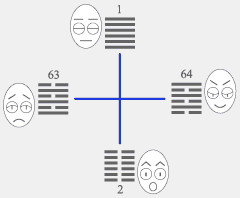 |
 Hexagonal symbol of 1st hexagram.
Hexagonal symbol of 1st hexagram.
|
Shown four hexagrams i-jing and four physiognomic symbols are not circle, but
form so-called "cross of creation" in which four world elements are
interconnected:
1st hexagram and physiognomic symbol there correspond to elements of earth;
2nd hexagram and physiognomic symbol there correspond to elements of air;
63rd hexagram and physiognomic symbol there correspond to elements of water;
64th hexagram and physiognomic symbol there correspond to elements of fire.
The others 60 hexagrams and 60 physiognomic symbols form circles.
The first circle.
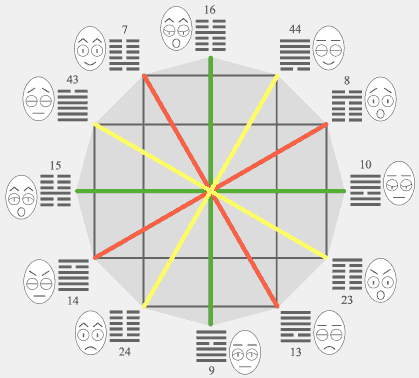 |
 Hexagonal symbol of 7, 8, 15, 16, 23, 24 hexagrams.
|
Circles are formed according to parities of hexagrams i-jing in pairs and quadras.
The detailed information on pairs and quadras look on the first page in this
section of website.
Quadras are located cross-wisely and designated by red, yellow, green crosses.
Blue crosses designate hexagrams which make pairs, but do not make quadras.
Grey lines show parities of hexagrams i-jing and physiognomic symbols concerning
verticals and horizontals of circles. Namely grey lines specify quadrangles in
which emotional expressions have concrete parities that is criterion according
to which positions of hexagrams and physiognomic symbols are placed within the
shown circles.
For example in the first circle, quadrangles of grey lines connect hexagrams and
physiognomic symbols in which emotions of eyes are identical concerning
verticals, and emotions of eyes are different concerning horizontals.
Or in the second circle, quadrangles of grey lines connect hexagrams and
physiognomic symbols so that in each quadrangle there are four kinds of
emotions.
And also in other circles it is possible to see that positions of hexagrams and
corresponding physiognomic symbols are concrete concerning verticals and
horizontals, and also concerning quadrangles of grey lines according to ratio of
emotions.
The information on interrelations of physiognomic symbols with hexagrams i-jing
look in other section which has the name concepts
of the canon of changes.
-
The second circle.
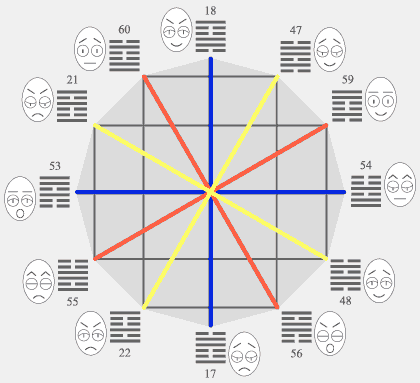 |
 Hexagonal symbol of 17, 18, 21, 22, 47, 48, 53, 54, 55, 56, 59, 60 hexagrams. |
The third circle.
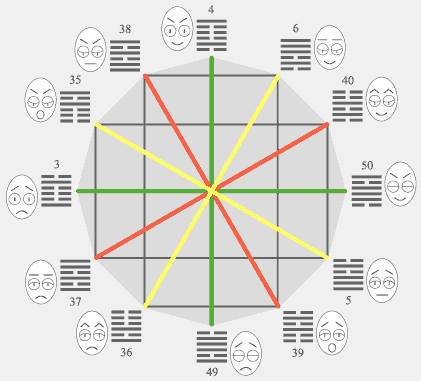 |
 Hexagonal symbol of 3, 4, 35, 36, 39, 40 hexagrams.
|
The fourth circle.
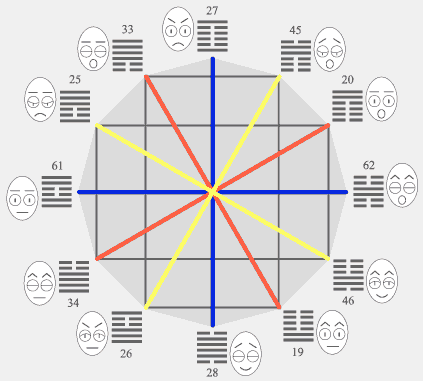 |
 Hexagonal symbol of 19, 20, 45, 46, 27, 62 hexagrams.
|
The fifth circle.
 |
 Hexagonal symbol of 29, 51, 52 hexagrams.
|
In the shown circles it is possible to see ratio or aspects which are in
essence similar to aspects in astrology. Namely the shown circles of hexagrams
and physiognomic symbols can be correlated to division of astrological circle
into 12 parts and 12 zodiac signs, though it is impossible to correlate to
concrete signs on the zodiac.
For example in the fifth circle, 11th and 42nd symbols have aspect of 120
degrees that means the harmonious parity, but 11th and 30th symbols have aspect
of 90 degrees that means the intense parity.
Or 11th and 57th symbols have aspect of 60 degrees that means the harmonious
parity, but 11th and 12th symbols have aspect of 180 degrees that means the
intense parity.
Or 11th and 41st symbols have aspect of 30 degrees that means a favorable
parity.
Or 11th and 52nd symbols have aspect of 150 degrees that also means a favorable
parity.
The detailed information on the harmonious and intense
aspects in astrology
look on pages of other website www.numeralgame.64g.ru/en.htm.
In essence in the shown circles of hexagrams i-jing and physiognomic symbols it
is possible to see symbolical parities of human emotions, and consequently it is
possible to speak about circles of emotions according to which there are
emotional mutual relations of people. Namely it is possible to assume that
people have interrelations in mutual relations if emotional expressions of faces
correspond to physiognomic symbols in this or that circle. And also it is
possible to assume that emotional expressions of faces change during relations
within of any one circle. Or it is possible to assume that there are
interrelations or correlations in mutual relations of people if emotional
expressions correspond to physiognomic symbols in different circles of emotions.
And also it is possible to do other assumptions, namely the question on the
harmonious and intense aspects of emotional displays now remains open.
In the future I shall try to investigate this question in sections which have
names transactions and
emotional types as the shown circles of emotions allow to
systematize emotional types of a human personality, and also allow to
systematize human mutual relations according to emotions which are peculiar to
different emotional types of a human personality.
The following page represents the incorporated scheme of five circles of emotions.
-